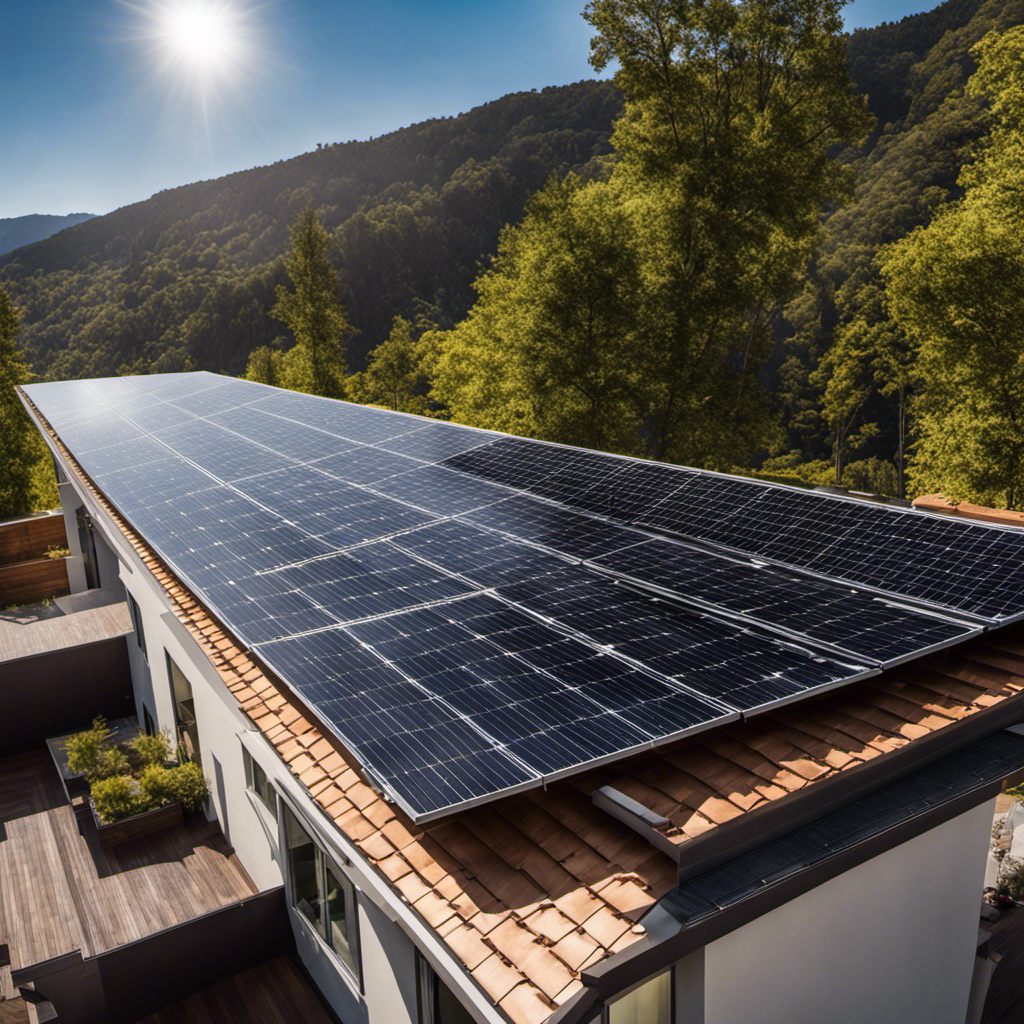Solar
Enhancing Solar Panel Efficiency: Technologies and Strategies

I have always been intrigued by the untapped potential of solar panels as a solar energy enthusiast.
In this article, we delve into the world of enhancing solar panel efficiency through cutting-edge technologies and strategic approaches.
From advanced materials to tracking systems and optimized placement, we explore the innovations driving the industry forward.
With the integration of energy storage, we unlock new levels of efficiency.
Join me on this journey as we uncover the possibilities and push the boundaries of solar power generation.
Key Takeaways
- Nanostructured coatings and quantum dot technology can enhance the absorption and conversion of sunlight, improving solar panel efficiency.
- Tracking systems and regular cleaning are important for maintaining high efficiency by allowing panels to follow the sun’s path and removing debris that can reduce performance.
- Optimizing solar panel placement and orientation, including considering tilt angles and avoiding shading, greatly impacts efficiency.
- Integration of energy storage systems, such as batteries and pumped hydro storage, can maximize the utilization of renewable energy resources and ensure a continuous supply of electricity.
Advanced Materials for Solar Panels
I’m excited to learn about the potential of advanced materials in improving solar panel efficiency.
One promising technology is the use of nanostructured coatings. These coatings consist of thin layers of materials with nano-sized features, which can enhance the absorption and conversion of sunlight into electricity. By carefully designing the nanostructure of these coatings, we can control the light absorption and reflection properties, maximizing the efficiency of solar panels.
Another exciting development is quantum dot technology. Quantum dots are tiny semiconductor particles that can be tuned to absorb specific wavelengths of light. By incorporating quantum dots into solar panels, we can expand their light absorption range and improve their overall efficiency. The unique properties of quantum dots, such as their size-dependent bandgap, make them ideal for enhancing solar panel performance.
Through further research and development, these advanced materials hold great promise for revolutionizing the efficiency of solar panels.
Tracking Systems for Optimal Sunlight Capture
To achieve optimal sunlight capture, using tracking systems is crucial. These systems allow solar panels to follow the sun’s path throughout the day, maximizing the amount of sunlight they receive.
However, to maintain high efficiency, regular maintenance is necessary. Solar panel cleaning techniques play a vital role in ensuring maximum sunlight absorption. Dust, dirt, and debris can accumulate on the surface of the panels, reducing their efficiency. Cleaning them regularly helps to remove these obstructions and maintain their performance.
Additionally, weather conditions can also impact solar panel efficiency. Cloudy or overcast days can significantly reduce the amount of sunlight reaching the panels, resulting in decreased energy production. Therefore, it’s essential to consider weather patterns and conditions when designing and implementing solar tracking systems.
Optimizing solar panel placement and orientation is the next crucial step to further enhance their efficiency.
Optimizing Solar Panel Placement and Orientation
When considering optimal sunlight capture, one important factor to take into account is the placement and orientation of the solar panels. The tilt angle of the solar panels plays a crucial role in maximizing their performance. Different tilt angles are recommended depending on the geographical location. For example, in locations closer to the equator, a tilt angle equal to latitude is often considered optimal. However, in regions with higher latitudes, a steeper tilt angle may be necessary to capture more sunlight throughout the year. Additionally, shading can have a significant impact on solar panel performance. It is important to avoid any shading on the panels, as even a small amount of shading can decrease the overall efficiency of the solar array. Proper placement and orientation, along with careful consideration of tilt angles and shading, can greatly enhance the efficiency of solar panels.
| Tilt Angle | Optimal Latitude |
|---|---|
| 0 degrees | 0-5 degrees |
| 30 degrees | 15-25 degrees |
| 45 degrees | 30-50 degrees |
Innovations in Solar Panel Design and Manufacturing
Innovations in solar panel design and manufacturing have revolutionized the industry, making renewable energy more accessible and efficient.
One significant aspect of these innovations is the focus on solar panel aesthetics and architectural integration. Manufacturers are now producing panels that blend seamlessly with the surrounding environment, allowing for more versatile and aesthetically pleasing installations. This integration not only enhances the visual appeal of solar panels but also encourages their adoption in urban and residential areas.
Another area of advancement is the improvement in solar panel durability and lifespan. Manufacturers are using advanced materials and techniques to make panels more resistant to environmental factors such as extreme temperatures, humidity, and even hailstorms. This increased durability ensures that solar panels can withstand harsh conditions and continue to generate electricity for an extended period, maximizing their return on investment.
These innovations in solar panel design and manufacturing pave the way for the integration of energy storage for increased efficiency. By combining solar panels with energy storage systems, excess energy can be stored and used during periods of low sunlight, reducing reliance on the grid and further optimizing the utilization of renewable energy resources.
Integration of Energy Storage for Increased Efficiency
The integration of energy storage systems maximizes the utilization of renewable energy resources, allowing me to store excess energy for use during periods of low sunlight. This is a crucial aspect of energy management and grid integration. By incorporating energy storage technologies into solar panel systems, we can overcome the intermittent nature of solar energy and ensure a continuous supply of electricity. These energy storage systems, such as batteries or pumped hydro storage, store the surplus energy generated by solar panels during peak sunlight hours and release it when needed. This enables a more efficient use of renewable energy and reduces reliance on traditional power sources. The table below highlights the benefits of integrating energy storage systems into solar panel installations:
| Benefits of Energy Storage Integration |
|---|
| Increased self-consumption of solar energy |
| Improved grid stability and reliability |
| Ability to shift excess energy to peak demand periods |
| Reduced reliance on fossil fuels |
Frequently Asked Questions
How Do Solar Panels Work?
Solar panels work by converting sunlight into electricity through the use of photovoltaic cells. These cells absorb photons from the sun and generate an electric current. The design and efficiency of solar panels play a crucial role in maximizing energy production.
What Are the Different Types of Solar Panels Available in the Market?
There are many different types of solar panels available in the market. Factors such as efficiency and advancements play a crucial role in choosing the right solar panel for your energy needs.
What Are the Environmental Benefits of Using Solar Panels?
Using solar panels in the manufacturing process significantly reduces greenhouse gas emissions, making it an environmentally friendly choice. They have a positive impact on reducing our carbon footprint and help combat climate change.
Can Solar Panels Generate Electricity During Cloudy or Rainy Days?
During cloudy or rainy days, solar panels can still generate electricity, albeit at a reduced efficiency. However, with advancements in technology and the use of alternative energy sources, we are constantly overcoming these limitations and enhancing solar panel performance.
How Long Do Solar Panels Typically Last and What Is Their Maintenance Requirement?
Solar panels typically last for 25 to 30 years with proper maintenance. Regular cleaning, inspection for damage or debris, and occasional repairs ensure optimal performance. Maintenance needs may vary depending on factors like climate and installation location.
Conclusion
In conclusion, the continuous advancements in technology and strategies for enhancing solar panel efficiency have shown great promise. With the use of advanced materials, tracking systems, optimized placement and orientation, innovative designs, and integration of energy storage, we can maximize energy capture and utilization.
As the saying goes, ‘Every cloud has a silver lining,’ the future of solar power looks bright, offering a sustainable and environmentally friendly solution for meeting our energy needs.
Solar
Solar Energy and Environmental Education

Passionate about a sustainable future, I’m excited to reveal the amazing **benefits** of solar energy and how it helps teach us about protecting our environment. Explore this illuminating journey and discover the wonders of harnessing the sun’s energy for a cleaner world!
Solar energy is a game-changer, providing countless benefits for both our planet and future generations.
In this article, we will explore how we can integrate solar energy into the curriculum, promote renewable energy awareness, and engage students in sustainable practices.
Together, let’s harness the power of the sun to create a brighter, more sustainable world.
Key Takeaways
- Solar energy is a highly efficient and clean source of power, reducing air pollution and combating climate change.
- Integrating solar energy into the curriculum enhances student engagement and fosters a deeper understanding of sustainable practices.
- Promoting renewable energy awareness through workshops, collaborations, and social media platforms is crucial for building a sustainable future.
- Engaging students in sustainable practices empowers them to make positive changes in their own lives and instills a sense of responsibility towards the environment.
The Benefits of Solar Energy
I’m convinced that solar energy offers numerous environmental and economic benefits.
One of the major advantages of solar energy is its efficiency. Solar panels convert sunlight directly into electricity, which means that there are no energy losses during transportation or distribution. This makes solar energy one of the most efficient forms of renewable energy available today.
Additionally, solar energy is a clean source of power, meaning that it produces no harmful emissions or pollutants. This helps to reduce air pollution and combat climate change.
Moreover, solar energy is a reliable and sustainable resource as long as the sun continues to shine. With advancements in technology, the efficiency of solar panels has also improved, making them even more cost-effective for homeowners and businesses.
Overall, solar energy offers a range of advantages in terms of efficiency, environmental sustainability, and economic benefits.
Integrating Solar Energy Into the Curriculum
As an educator, I’ve found that integrating solar power into the curriculum enhances student engagement and fosters a deeper understanding of sustainable practices. By incorporating solar energy applications and renewable energy integration into various subjects, students not only learn about the science behind solar power but also develop critical thinking skills and problem-solving abilities.
They become aware of the environmental benefits of renewable energy sources and gain a sense of responsibility towards preserving our planet. Through hands-on activities, such as building solar-powered devices or conducting experiments with solar panels, students can see firsthand how solar energy works and its potential for a greener future.
Promoting Renewable Energy Awareness
Promoting renewable energy awareness is crucial for building a sustainable future. As someone passionate about renewable energy, I understand the importance of community outreach and education. By organizing renewable energy workshops, we can provide valuable information and resources to our community.
Here are three ways we can effectively promote renewable energy awareness:
-
Hosting workshops: These interactive sessions will educate individuals about the benefits of renewable energy and how they can incorporate it into their daily lives.
-
Collaborating with local organizations: By partnering with local environmental groups or community centers, we can reach a wider audience and increase the impact of our outreach efforts.
-
Utilizing social media: Sharing informative content, success stories, and practical tips on platforms like Facebook and Instagram can engage and inspire a larger online community.
Together, through community outreach and renewable energy workshops, we can create a more sustainable future for generations to come.
Engaging Students in Sustainable Practices
Engaging students in sustainable practices is a key aspect of creating a greener future. By involving students in green initiatives and encouraging their active participation, we can cultivate a generation of environmentally conscious individuals. Educating students about sustainable practices not only empowers them to make positive changes in their own lives, but also instills a sense of responsibility towards the environment.
One effective way to engage students is by incorporating sustainability into the curriculum. By integrating topics like renewable energy, waste reduction, and conservation into various subjects, we can provide students with a comprehensive understanding of sustainable practices. Additionally, hands-on activities and interactive projects can further enhance their learning experience.
Furthermore, student participation in sustainability initiatives can extend beyond the classroom. Schools can organize events like tree planting, recycling drives, and energy conservation campaigns, where students actively participate and contribute to making a difference. These practical experiences not only reinforce the importance of sustainable practices but also foster a sense of ownership and environmental stewardship among students.
Collaborating With Communities for a Greener Future
Collaborating with communities is essential for creating a greener future. By forming strong community partnerships, we can work together to implement sustainable initiatives that have a lasting impact on the environment.
Here are three key benefits of collaborating with communities:
-
Increased awareness: When we partner with communities, we can raise awareness about the importance of sustainability and the benefits of renewable energy sources like solar power. By engaging with community members, we can educate them about the positive impact of sustainable initiatives and inspire them to take action.
-
Local expertise: Communities possess valuable knowledge about their specific needs and challenges. By collaborating with them, we can tap into this local expertise and tailor our sustainable initiatives to address their unique circumstances. This ensures that our efforts are effective and sustainable in the long run.
-
Shared resources: Working together with communities allows us to pool our resources and achieve greater impact. By combining our expertise, funding, and manpower, we can implement larger-scale projects that benefit not only the community but also the environment as a whole.
Through strong community partnerships and sustainable initiatives, we can create a greener future that benefits everyone. Let’s join forces and make a positive change together.
Frequently Asked Questions
Are There Any Disadvantages or Limitations to Using Solar Energy?
There are indeed some disadvantages and limitations to using solar energy.
One major limitation is that solar panels can only generate electricity when the sun is shining, so they aren’t as reliable during cloudy or nighttime conditions.
Additionally, solar energy can be expensive to install and maintain, making it less accessible for some individuals or communities.
Another drawback is the large amount of space required for solar farms, which may not be feasible in densely populated areas.
How Does Solar Energy Compare to Other Renewable Energy Sources in Terms of Efficiency and Cost?
When comparing solar energy to other renewable energy sources in terms of efficiency and cost, it’s important to consider the numbers.
Efficiency-wise, solar panels have come a long way, with average conversion rates of 15-20%. This means that 15-20% of sunlight is converted into usable electricity.
In terms of cost, solar energy is becoming increasingly affordable, with prices dropping by 89% in the last decade. This makes solar energy a highly efficient and cost-effective choice for renewable energy.
What Are Some Potential Challenges or Barriers Educators May Face When Integrating Solar Energy Into the Curriculum?
When it comes to integrating solar energy into the curriculum, educators may face several challenges and barriers.
These can include a lack of resources and funding for solar installations, limited access to training and professional development opportunities, and resistance from stakeholders who may not see the value in incorporating solar energy into the curriculum.
Additionally, there may be logistical challenges in terms of finding appropriate curriculum materials and ensuring that students have the necessary knowledge and skills to participate in solar energy projects.
How Can Students Actively Participate in Promoting Renewable Energy Awareness Within Their Communities?
As a student, I believe that student-led initiatives are crucial in promoting renewable energy awareness within our communities. By actively engaging with our peers and community members, we can organize events and campaigns that educate and inform others about the benefits of renewable energy.
Through workshops, presentations, and hands-on projects, we can inspire others to take action and make a positive impact on our environment. It’s essential that we work together to create a sustainable future for generations to come.
What Are Some Successful Examples of Collaborative Projects Between Schools and Communities to Promote Sustainable Practices and Solar Energy Adoption?
Collaborative projects between schools and communities can have a significant impact on promoting sustainable practices. By working together, we can create innovative initiatives that encourage the adoption of solar energy and other renewable sources.
These projects allow students to actively participate in real-world scenarios, fostering a sense of responsibility and awareness towards environmental issues. Through hands-on experiences, students gain a deeper understanding of the benefits of sustainable living and the positive impact it has on our planet.
In addition to educating students, these collaborations also inspire and engage the wider community. By showcasing successful sustainable projects, schools and communities can encourage others to follow suit and implement similar initiatives. This ripple effect can lead to a widespread adoption of sustainable practices, ultimately contributing to a more environmentally friendly society.
Conclusion
As I reflect on the power of solar energy and environmental education, I’m reminded of the sun’s unwavering presence in our lives. Just as the sun provides light and warmth, solar energy illuminates our path towards a greener future.
By integrating solar energy into our curriculum and promoting renewable energy awareness, we empower our students to be the catalysts of change.
Together, let’s harness the energy of the sun and create a sustainable world for generations to come.
Solar
Who Benefits Most From Solar Energy, Who The Least

I have always been curious about the individuals or groups that are most and least impacted by solar energy. As solar energy continues to gain popularity, it is crucial to consider the economic inequalities and social consequences associated with its adoption.
In this article, we’ll explore the government policies and support for solar energy, as well as the challenges faced by low-income communities in embracing this renewable source.
Join me as we delve into solutions for ensuring the equitable distribution of solar energy benefits.
Key Takeaways
- Economic disparities and financial constraints hinder access to solar energy for low-income communities and developing countries.
- The adoption of solar energy has positive social and environmental impacts, including reduced greenhouse gas emissions, job creation, and improved quality of life.
- Government policies and incentives have helped make solar energy more affordable and driven investment in renewable energy projects.
- Challenges for low-income communities in embracing solar energy include limited access to capital, lack of knowledge, and limited community engagement. Overcoming these barriers requires community partnerships, education, and financial support.
Economic Disparities and Solar Energy Access
I believe that economic disparities play a significant role in determining who has access to solar energy and who does not.
Economic inequality and energy poverty are closely tied to the availability and affordability of solar energy solutions. According to data, low-income communities and developing countries face greater challenges in accessing solar energy due to financial constraints.
High upfront costs, installation expenses, and maintenance fees make it difficult for economically disadvantaged individuals to adopt solar energy systems. This perpetuates a cycle where those who can afford it benefit from the advantages of solar power, such as reduced electricity bills and environmental benefits, while others are left behind.
Bridging the economic gap and providing financial support to underserved communities is crucial in ensuring equitable access to solar energy and addressing energy poverty.
Social and Environmental Impact of Solar Energy Adoption
As a homeowner, my monthly electricity bills have significantly decreased since adopting solar energy, positively impacting both my wallet and the environment.
The transition to renewable energy hasn’t only empowered my community but also led to various social and environmental benefits.
According to data, solar energy adoption has reduced greenhouse gas emissions, contributing to a cleaner and healthier environment.
It has also created job opportunities, stimulating economic growth and community empowerment.
Additionally, solar energy has provided reliable and affordable electricity to underserved areas, bridging the energy access gap and improving the quality of life for many.
Government Policies and Support for Solar Energy
The government’s commitment to promoting renewable energy through favorable policies and financial incentives has greatly accelerated the adoption of solar power. Government incentives, such as tax credits and grants, have provided financial support to homeowners, businesses, and utilities to invest in solar energy systems. These incentives have helped reduce the upfront costs of installation and made solar power more affordable for many.
In addition, the government has set renewable energy targets to encourage the transition to clean energy sources. These targets have created a sense of urgency and have driven investment in solar energy projects. As a result, the solar industry has experienced significant growth, creating jobs and reducing greenhouse gas emissions.
However, despite these government efforts, there are still challenges for low-income communities in embracing solar energy.
Challenges for Low-Income Communities in Embracing Solar Energy
Low-income communities face financial barriers that hinder their ability to adopt solar power and benefit from the cost savings and environmental advantages it offers. Many factors contribute to these challenges, including limited access to capital, lack of knowledge about solar energy, and the absence of community engagement initiatives.
To illustrate the extent of these challenges, let’s consider the following table:
| Challenges | Impact on Low-Income Communities |
|---|---|
| Limited Access to Capital | Prevents investment in solar infrastructure |
| Lack of Knowledge | Hinders understanding of solar benefits and technology |
| Absence of Community Engagement Initiatives | Limits awareness and support for solar initiatives |
To overcome these barriers, it is crucial to focus on community engagement, education, and awareness. By providing accessible information, training, and financial assistance programs, we can empower low-income communities to embrace solar energy and reap its benefits. Encouraging partnerships between solar companies, government agencies, and community organizations can also play a significant role in overcoming these challenges.
Solutions for Ensuring Equitable Distribution of Solar Energy Benefits
To ensure equitable distribution of solar power advantages, I believe it’s crucial to prioritize accessibility and inclusivity in the implementation of solar energy initiatives.
By forming strong community partnerships, we can ensure that solar energy benefits are accessible to all, regardless of income or social status. These partnerships can help identify and address the specific needs of different communities, ensuring that solar energy initiatives are tailored to their requirements.
Additionally, providing financial incentives can further encourage the adoption of solar energy in low-income communities. These incentives can include grants, tax credits, or subsidies that make solar energy more affordable for those who need it the most.
Frequently Asked Questions
What Are the Potential Health Benefits of Solar Energy Adoption for Low-Income Communities?
Solar energy adoption has the potential to bring significant health benefits to low-income communities. By reducing air pollution and improving overall environmental quality, solar energy can contribute to environmental justice and promote community health.
How Do Government Subsidies and Incentives Impact the Affordability of Solar Energy for Different Income Groups?
Government incentives play a crucial role in making solar energy affordable for different income groups. However, income disparity can limit access to these benefits, creating a need for targeted policies to ensure equal opportunities for all.
How Does the Installation and Maintenance of Solar Panels Affect Property Values in Low-Income Communities?
The installation and maintenance of solar panels in low-income communities can positively impact property values and provide health advantages. This can lead to increased affordability and access to clean energy for those who need it most.
Are There Any Potential Drawbacks or Unintended Consequences of Widespread Solar Energy Adoption in Low-Income Neighborhoods?
There are potential drawbacks and unintended consequences of widespread solar energy adoption in low-income neighborhoods. These include increased costs for residents, potential displacement, and unequal access to benefits.
What Are Some Innovative Financing Options or Community-Led Initiatives That Aim to Increase Access to Solar Energy for Disadvantaged Communities?
Innovative financing options and community-led initiatives are key to increasing access to solar energy for disadvantaged communities. These solutions can help address barriers and ensure that everyone can benefit from the advantages of solar energy.
Conclusion
In conclusion, while solar energy has the potential to benefit all communities, there are still economic disparities that affect access and distribution. According to a recent study, it was found that low-income households make up only a small percentage of solar energy adopters.
This highlights the need for government policies and support to ensure equitable distribution of solar energy benefits. By addressing these challenges, we can work towards a more inclusive and sustainable future powered by solar energy.
Solar
How Many Solar Panels Do I Need On My House To Become Energy Independent

So, you’re interested in achieving energy independence, huh? Get ready because we’re about to explore the realm of solar panels.
In this article, I’ll break down the factors that affect the number of panels you’ll need to power your house. We’ll calculate your energy consumption, evaluate available sunlight, and determine panel efficiency.
By the end, you’ll have a clearer picture of just how many solar panels it takes to break free from the grip of the grid.
Key Takeaways
- The amount of sunlight received and solar panel efficiency are key factors that affect energy generation.
- Analyzing monthly electricity bills and understanding net metering are important for calculating energy consumption and potential savings.
- Evaluating available sunlight, including potential shading factors and optimizing panel placement, is crucial for maximizing solar potential.
- Considering cost implications, maintenance requirements, and energy consumption patterns are essential for determining the ideal number of solar panels needed.
Factors Affecting Solar Panel Requirements
One of the factors that affects the number of solar panels I need for my house to become energy independent is the amount of sunlight my location receives. The more sunlight I receive, the more energy my solar panels can generate. This is an important consideration because it directly impacts the effectiveness and efficiency of the solar panels.
Additionally, cost considerations play a significant role in determining the number of solar panels needed. The upfront cost of installing solar panels can be expensive, so it’s essential to carefully calculate the number of panels required to maximize energy production while keeping costs manageable.
Fortunately, there are government incentives available that can help offset the cost of installing solar panels, such as tax credits and rebates. These incentives can make solar panel installation more affordable and encourage homeowners to invest in renewable energy sources.
Calculating Energy Consumption
To calculate my energy consumption, I’ll need to analyze my monthly electricity bills and determine the average amount of energy I use per month. This is crucial in understanding how many solar panels I’ll need to become energy independent.
By examining my bills over a year, I can get a better estimate of my energy usage patterns and identify any seasonal variations. Once I’ve this information, I can start estimating the costs of installing enough solar panels to cover my energy needs.
It’s important to consider the concept of net metering, which allows me to sell excess energy back to the grid. Understanding net metering will help me determine how many solar panels I’ll need to generate enough energy to offset my consumption and potentially earn credits from my utility company.
Evaluating Available Sunlight
I can evaluate the amount of sunlight that my location receives throughout the year by analyzing historical weather data and using online resources. This information is crucial for evaluating the solar potential of my property and optimizing panel placement.
Here are three key factors to consider when evaluating sunlight availability:
-
Sunlight Duration: Analyzing historical weather data will provide insight into the average number of sunny days and the duration of sunlight in my area. This information helps determine the overall solar potential.
-
Shading: Assessing the potential shading factors in my location is essential. Obstructions such as trees, buildings, or nearby structures can significantly impact the amount of sunlight that reaches my solar panels.
-
Sun Path: Understanding the sun’s path is crucial for optimizing panel placement. By knowing the direction and angle of sunlight throughout the year, I can position my solar panels to capture the maximum amount of energy.
Determining Panel Efficiency
Analyzing the efficiency ratings of different solar panels is crucial in determining which ones will generate the most electricity for my property. Maximizing output and optimizing performance are key factors in achieving energy independence through solar power.
When evaluating solar panels, it’s important to consider their efficiency ratings, which indicate how effectively they convert sunlight into electricity. Higher efficiency ratings mean that the panels can generate more electricity from the same amount of sunlight.
Finding the Ideal Number of Solar Panels
By determining the ideal number of solar panels for my property, I can ensure that I’m maximizing the amount of electricity generated. There are several factors to consider when finding the right number of panels for my needs:
-
Cost considerations: The number of panels will impact the initial cost of the system. More panels mean a higher upfront investment, but they also result in greater energy production and potential savings in the long run.
-
Maintenance requirements: Each panel requires regular cleaning and inspection to ensure optimal performance. Having too many panels can increase the maintenance workload, while having too few may not generate enough energy to meet my needs.
-
Energy consumption: It’s essential to analyze my household’s energy consumption to determine the number of panels required. By understanding my energy usage patterns, I can accurately estimate the number of panels needed to achieve energy independence.
Considering these factors, I can make an informed decision and find the ideal number of solar panels for my property.
Frequently Asked Questions
How Long Do Solar Panels Typically Last Before Needing to Be Replaced?
Solar panels typically last around 25-30 years before needing to be replaced, although some warranties can extend up to 40 years. Factors like weather conditions, maintenance, and quality of materials can affect their lifespan.
Are There Any Government Incentives or Tax Credits Available for Installing Solar Panels?
There are government incentives and tax credits available for installing solar panels. These incentives can help offset the installation costs and shorten the payback period, making solar energy more affordable and attractive.
Can I Sell Excess Energy Generated by My Solar Panels Back to the Power Grid?
Yes, you can sell excess energy generated by your solar panels back to the power grid. It’s a great way to offset your electricity costs and make your solar panel investment even more efficient.
What Kind of Maintenance Is Required for Solar Panels?
Solar panel cleaning and inspection are crucial for maintaining optimal performance. Regular cleaning removes dirt and debris that can hinder efficiency, while inspections ensure any issues are detected and resolved promptly.
How Does the Cost of Installing Solar Panels Compare to the Cost of Traditional Electricity?
Installing solar panels is a cost-effective and environmentally friendly alternative to traditional electricity. It reduces the reliance on fossil fuels and can save on monthly bills. The initial investment is offset by long-term savings.
Conclusion
After carefully evaluating factors such as energy consumption, available sunlight, and panel efficiency, it’s clear that the ideal number of solar panels needed to achieve energy independence varies for each household.
Becoming energy independent is a personal journey, but with the right information and resources, it’s an achievable goal. By harnessing the power of the sun, we can’t only reduce our reliance on traditional energy sources but also contribute to a cleaner and more sustainable future.
-

 Sustainable Supply Chain Management5 months ago
Sustainable Supply Chain Management5 months agoManagEnergy Acquires GPST2030.org Domain to Strengthen Commitment to Sustainable Transport
-

 Wind Energy5 months ago
Wind Energy5 months agoHow Much Oil Does It Take To Lubricate A Wind Turbine
-

 Electric Motorbike3 months ago
Electric Motorbike3 months agoCalifornia Electric Motorcycle Laws: A Comprehensive Guide to Riding Safely
-

 Solar4 months ago
Solar4 months agoIn 2009, About What Percent Of U.S. Energy Consumption Was Supplied By Solar Energy
-

 Electricity Vehicle3 months ago
Electricity Vehicle3 months agoThe Future of Electric Vehicles: Trends and Innovations to Watch
-

 Wind Energy3 months ago
Wind Energy3 months agoRevolutionizing Highways: Wind Turbines Take the Road to Renewable Energy
-

 Wind Energy4 months ago
Wind Energy4 months agoWhat Is The Minimum And Maximum Wind Speed For Operating A Wind Turbine
-

 Solar4 months ago
Solar4 months agoWhy Should We Use Solar Energy Instead Of Fossil Fuels




















